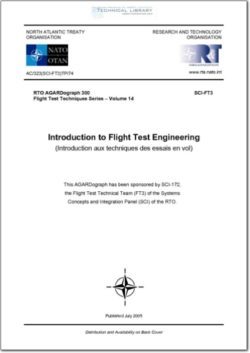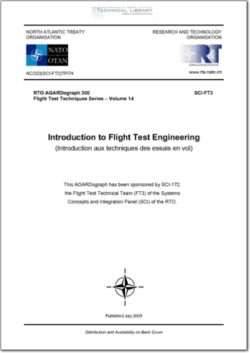AGARD-RTO-AG-300-V14

- Version
- 395 Downloads
- 11.19 MB File Size
- 1 File Count
- April 28, 2016 Create Date
- April 28, 2016 Last Updated
Introduction to Flight Test Engineering

Flight test is at the core of what organizations must do in order to validate the operation and systems on an
aircraft. While the AGARDograph series 300 and 160 series deal with aspects of this testing, this volume
pulls it all together as an introduction to the process required to do effective flight test engineering.
This volume was originally published in 1995. Its utility has been proven in that many flight test
organizations and universities have requested copies for their engineers and students. It was felt that
re-issuing it in a new format designed for electronic publication would be valuable to the community.
This second ‘printing’ changes none of the text, but rather reformats it. All the original references to
AGARD (instead of RTO) are left in place so that none of the flavor of the original publication is lost.
This is the Introductory Volume to the Flight Test Techniques Series. It is a general introduction to the
various activities and aspects of Flight Test Engineering that must be considered when planning,
conducting, and reporting a flight test program. Its main intent is to provide a broad overview to the
novice engineer or to other people who have a need to interface with specialists within the flight test
community. The first two Sections provide some insight into the question of why flight test and give a
short history of flight test engineering. Sections 3 through 10 deal with the preparation for flight testing.
They provide guidance on the preliminary factors that must be considered; the composition of the test
team; the logistic support requirements; the instrumentation and data processing requirements; the flight
test plan; the associated preliminary ground tests; and last, but by no means least, discuss safety aspects.
Sections 11 through 27 describe the various types of flight tests that are usually conducted during the
development and certification of a new or modified aircraft type. Each Section offers a brief introduction
to the topic under consideration, and the nature and the objectives of the tests to be conducted. It lists the
test instrumentation (and, where appropriate, other test equipment and facilities) required, describes the
test maneuvers to be executed, and indicates the way in which the test data is selected, analyzed, and
presented. The various activities that should take place between test flights are presented next. Items that
are covered are: who to debrief; what type of reports to send where: types of data analysis required for
next flight; review of test data to make a comparison to predicted data and some courses of action if there
is not good agreement; and comments on selecting the next test flight. The activities that must take place
upon completion of the test program are presented. The types of reports and briefings that should take
place and a discussion of some of the uses of the flight test data are covered. A brief forecast is presented
of where present trends may be leading.
| File | Action |
|---|---|
| AGARD-RTO-AG-300-V14 Introduction to Flight Test Engineering.pdf | Download |
Comment On This Post